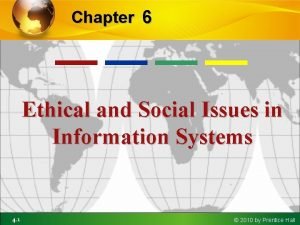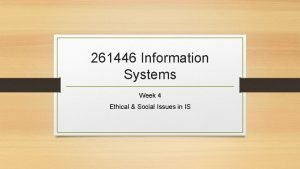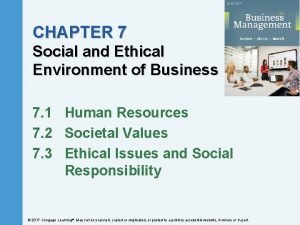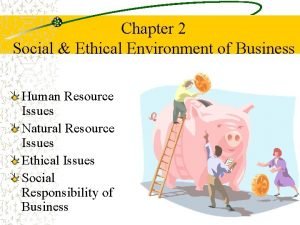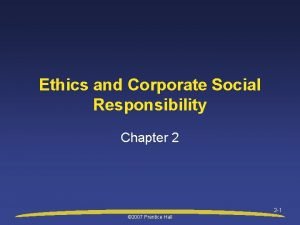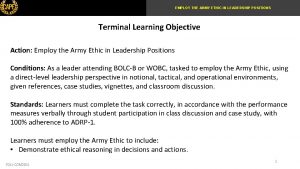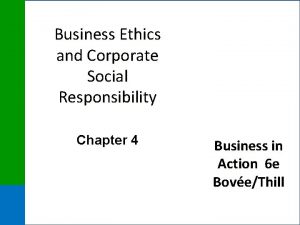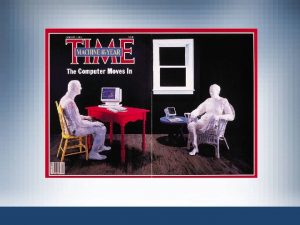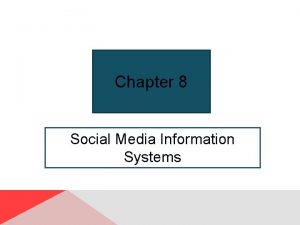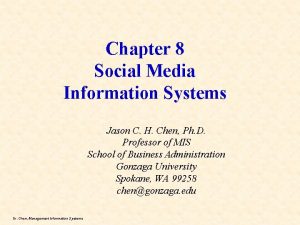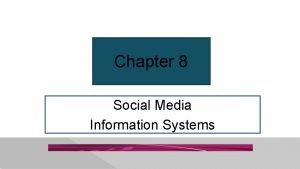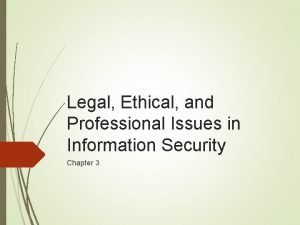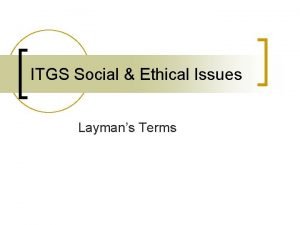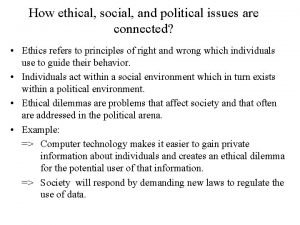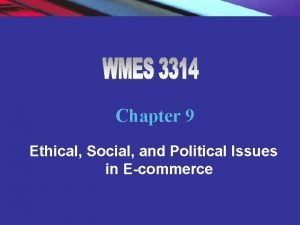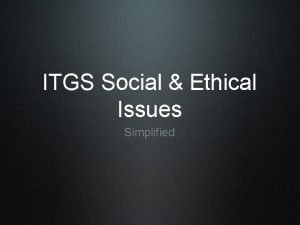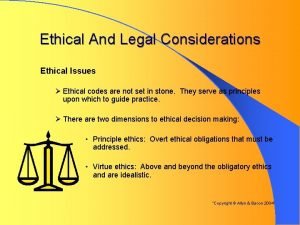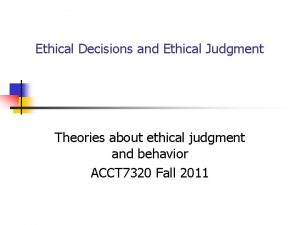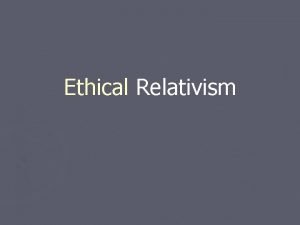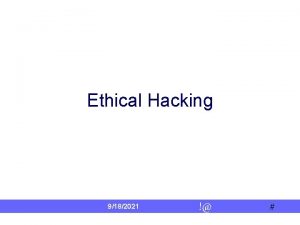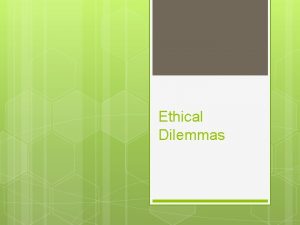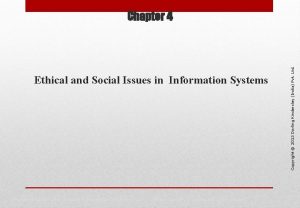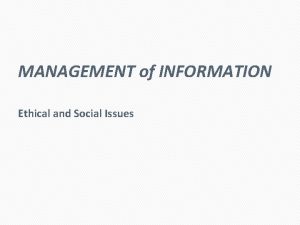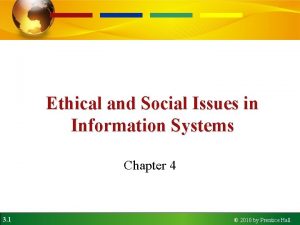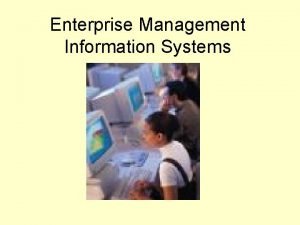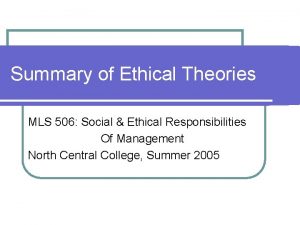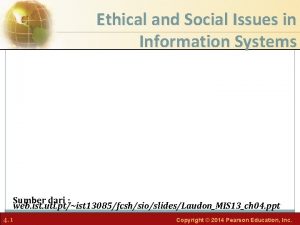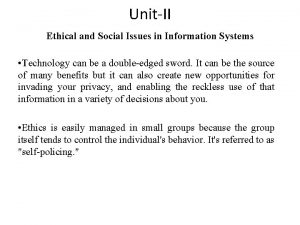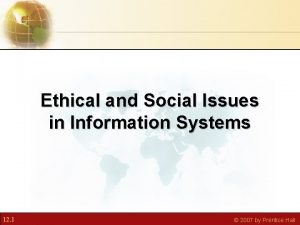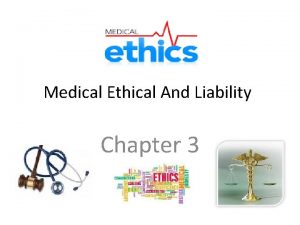Management Information Systems Chapter 4 Ethical and Social



























- Slides: 27

Management Information Systems Chapter 4 Ethical and Social Issues in Informaion Systems Hyunu Kim

LEARNING OBJECTIVES �Analyze the relationships among ethical, social, and political issues that are raised by information systems. �Identify the main moral dimensions of an information society and specific principles for conduct that can be used to guide ethical decisions. �Evaluate the impact of contemporary information systems and the Internet on the protection of individual privacy and intellectual property. �Assess how information systems have affected everyday life.

Does Location Tracking Threaten Privacy?

Understanding Ethical and Social Issues Related to Systems �Ethics �Principles of right and wrong that individuals, acting as free moral agents, use to make choices to guide their behavior �Information systems and ethics �Information systems raise new ethical questions because they create opportunities for: � Intense social change, threatening existing distributions of power, money, rights, and obligations � New kinds of crime

Understanding Ethical and Social Issues Related to Systems �A model for thinking about ethical, social, and political issues �Society as a calm pond �IT as a rock dropped in pond, creating ripples of new situations not covered by old rules �Social and political institutions cannot respond overnight to these ripples—it may take years to develop etiquette, expectations, laws �Requires understanding of ethics to make choices in legally gray areas

The Relationship Between Ethical, Social, and Political Issues in an Information Society

Understanding Ethical and Social Issues Related to Systems �Four key technology trends that raise ethical issues �Computing power doubles every 18 months � Increased reliance on, and vulnerability to, computer systems �Data storage costs rapidly declining � Multiplying databases on individuals �Data analysis advances � Greater ability to find detailed personal information on individuals � Profiling and nonobvious relationship awareness (NORA) �Networking advances and the Internet � Enables moving and accessing large quantities of personal data

Nonobvious Relationship Awareness (NORA)

Ethics in an Information Society �Basic concepts form the underpinning of an ethical analysis of information systems and those who manage them �Responsibility: Accepting the potential costs, duties, and obligations for decisions �Accountability: Mechanisms for identifying responsible parties �Liability: Permits individuals (and firms) to recover damages done to them �Due process: Laws are well known and understood, with an ability to appeal to higher authorities

Ethics in an Information Society �Ethical analysis: A five-step process �Identify and clearly describe the facts �Define the conflict or dilemma and identify the higherorder values involved �Identify the stakeholders �Identify the options that you can reasonably take �Identify the potential consequences of your options

Ethics in an Information Society �Candidate Ethical Principles �Golden Rule � Do unto others as you would have them do unto you �Immanuel Kant’s Categorical Imperative � If an action is not right for everyone to take, it is not right for anyone �Descartes' rule of change � If an action cannot be taken repeatedly, it is not right to take at all

Ethics in an Information Society �Candidate Ethical Principles (cont. ) �Utilitarian Principle � Take the action that achieves the higher or greater value �Risk Aversion Principle � Take the action that produces the least harm or least potential cost �Ethical “no free lunch” rule � Assume that virtually all tangible and intangible objects are owned by someone unless there is a specific declaration otherwise

The Moral Dimensions of Information Systems

The Moral Dimensions of Information Systems �Information rights and obligations �Privacy Claim of individuals to be left alone, free from surveillance or interference from other individuals, organizations, or the state. � The claim to be able to control information about yourself � �In U. S. , privacy protected by: � First Amendment (freedom of speech) � Fourth Amendment (unreasonable search and seizure) � Additional federal statues � Privacy Act of 1974

The Moral Dimensions of Information Systems �Internet Challenges to Privacy: �Cookies � Tiny files downloaded by Web site to visitor’s hard drive � Identify visitor’s browser and track visits to site � Allow Web sites to develop profiles on visitors �Web bugs � Tiny graphics embedded in e-mail messages and Web pages � Designed to monitor who is reading a message and transmitting that information to another computer on the Internet �Spyware � Surreptitiously installed on user’s computer � May transmit user’s keystrokes or display unwanted ads

How Cookies Identify Web Visitors

The Moral Dimensions of Information Systems �U. S. allows businesses to gather transaction information and use this for other marketing purposes �Online industry promotes self-regulation over privacy legislation �Self regulation has proven highly variable �Statements of information use are quite different �Some firms offer opt-out selection boxes �Online “seals” of privacy principles �Most Web sites do not have any privacy policies �Many online privacy policies do not protect customer privacy, but rather protect the firm from law suits

The Moral Dimensions of Information Systems �Technical solutions �The Platform for Privacy Preferences (P 3 P) � Allows Web sites to communicate privacy policies to visitor’s Web browser – user � User specifies privacy levels desired in browser settings � E. g. “medium” level accepts cookies from first-party host sites that have opt-in or opt-out policies but rejects third-party cookies that use personally identifiable information without an opt-in policy.

The P 3 P Standard

The Moral Dimensions of Information Systems �Property Rights: Intellectual Property �Intellectual property: Intangible property of any kind created by individuals or corporations �Three ways that intellectual property is protected Trade secret: � Intellectual work or product belonging to business, not in the public domain � Copyright: � Statutory grant protecting intellectual property from being copied for the life of the author, plus 70 years � Patents: � Grants creator of invention an exclusive monopoly on ideas behind invention for 20 years �

The Moral Dimensions of Information Systems �Challenges to Intellectual Property Rights �Digital media different from physical media (e. g. books) � Ease of replication � Ease of transmission (networks, Internet) � Difficulty in classifying software � Compactness � Difficulties in establishing uniqueness �Digital Millenium Copyright Act (DMCA) �Makes it illegal to circumvent technology-based protections of copyrighted materials

The Moral Dimensions of Information Systems �Accountability, Liability, Control �Computer-related liability problems � If software fails, who is responsible? � If seen as a part of a machine that injures or harms, software producer and operator may be liable � If seen as similar to a book, difficult to hold software author/publisher responsible � What should liability be if software is seen as service? Would this be similar to telephone systems not being liable for transmitted messages (so-called “common carriers”)

The Moral Dimensions of Information Systems �System Quality: Data Quality and System Errors �What is an acceptable, technologically feasible level of system quality? � Flawless software is economically unfeasible �Three principal sources of poor system performance: � Software bugs, errors � Hardware or facility failures � Poor input data quality (most common source of business system failure)

The Moral Dimensions of Information Systems �Quality of Life: Negative social consequences of systems �Balancing power: Although computing power is decentralizing, key decision-making power remains centralized �Rapidity of change: Businesses may not have enough time to respond to global competition �Maintaining boundaries: Computing and Internet use lengthens the work-day, infringes on family, personal time �Dependence and vulnerability: Public and private organizations ever more dependent on computer systems

The Moral Dimensions of Information Systems �Computer crime and abuse � Computer crime: Commission of illegal acts through use of compute or against a computer system – computer may be object or instrument of crime � Computer abuse: Unethical acts, not illegal � Spam: High costs for businesses in dealing with spam �Employment: Reengineering work resulting in lost jobs �Equity and access – the digital divide: Certain ethnic and income groups in the United States less likely to have computers or Internet access

The Spamming Problem

Homework �Personal Work (1 ~ 2 page) �Review Questions: 2, 3, 10, 13 �Team Work � 4. 4 Hands-on MIS � Developing a Web Site Privacy Policy
 Chapter 4 ethical issues
Chapter 4 ethical issues Chapter 4 ethical and social issues in information systems
Chapter 4 ethical and social issues in information systems Social issues in mis
Social issues in mis Ethical and social issues in information systems doc
Ethical and social issues in information systems doc Ethical and social issues in information systems
Ethical and social issues in information systems Ethical habits
Ethical habits Chapter 2 social and ethical environment of business
Chapter 2 social and ethical environment of business Chapter 7 social and ethical environment of business
Chapter 7 social and ethical environment of business Chapter 2 social and ethical environment of business
Chapter 2 social and ethical environment of business System chapter 1
System chapter 1 Introduction of management information system
Introduction of management information system Perbedaan ethical dilemma dan ethical lapse
Perbedaan ethical dilemma dan ethical lapse Ethical reasoning model army
Ethical reasoning model army Perspectives of csr
Perspectives of csr The writer properly quotes and cited sources in some places
The writer properly quotes and cited sources in some places Professional issues in information security
Professional issues in information security Specialized information systems
Specialized information systems Social media information system
Social media information system Social media information systems
Social media information systems Social media information systems
Social media information systems Chapter 3 information systems organizations and strategy
Chapter 3 information systems organizations and strategy Legal and ethical issues in information security
Legal and ethical issues in information security Itgs social and ethical issues
Itgs social and ethical issues How ethical social and political issues are connected
How ethical social and political issues are connected The social and ethical perspectives of entrepreneurship
The social and ethical perspectives of entrepreneurship Ethical social and political issues in e-commerce
Ethical social and political issues in e-commerce Itgs social and ethical issues
Itgs social and ethical issues Example of middle level management
Example of middle level management



